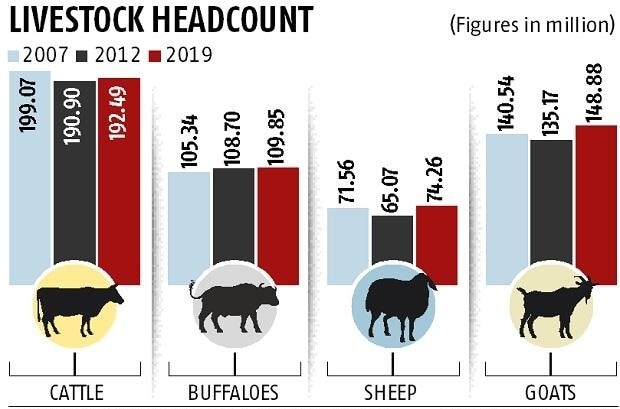20th Livestock Census | 17 Oct 2019
Ministry of Fisheries, Animal Husbandry and Dairying has released the 20th Livestock Census report recently.
- The release provides key results reflecting the aggregate counts of various species as well as its comparison with the previous census.
Key Points
- The total Livestock population is 535.78 million in the country showing an increase of 4.6% over Livestock Census-2012.
- West Bengal observed the highest increase of 23%, followed by Telangana (22%).
- The total number of cattle in the country has shown an increase of 0.8 %.
- The increase is mainly driven by a sharp increase in cross-bred cattle and higher female indigenous cattle population.
- Uttar Pradesh has observed a maximum decrease in cattle population though the state has taken several steps to save cattle.
- West Bengal has seen the highest rise of 15% in cattle population.
- The population of the total exotic/crossbred cattle has increased by 27%.
- Cross-bred animals contributed around 28% to India’s total milk production in 2018-19.
- The milch population of exotic and crossbred cattle such as Jersey or Holsteins shows higher milk yields and thus farmers prefer animals yielding more milk.
- A decline of 6% in the total indigenous cattle population has been observed.
- India’s indigenous cattle numbers continue to decline, notwithstanding the government’s efforts to promote conservation of desi breeds through the Rashtriya Gokul Mission (RGM).
- The sharpest fall has been observed in the states (Uttar Pradesh, Madhya Pradesh, Rajasthan,Maharashtra, etc.) with tough cow slaughter laws.
- The total milch animals have shown an increase of 6%.
- Due to higher yields, foreign breeds constitute more than half the population of milch animals.
- The more the number of animals that produce milk, the more would be pressure on land and fiercer would be competition between man and animals for survival.
- The figures show that nearly 75% of total cattle in the country are female (cows)-- a clear sign of dairy farmers' preferences for milk-producing cattle. This also gained momentum in the past couple of years due to the government's assistance in terms of providing sex-sorted artificial insemination (AI), with semen of high-yielding bulls, free of cost at farmers' doorstep.
- The backyard poultry has increased by around 46%.
- The sharp increase in backyard poultry is a significant change in the rural landscape which shows a sign of poverty alleviation.
- Total Bovine population (Cattle, Buffalo, Mithun and Yak) has shown an increase of about 1%.
- The population of sheep, goat and Mithun grew in double digits while the count of horses and ponies, pigs, camels, donkeys, mules and yaks declined.
The Livestock Census
- The Livestock Census has been conducted in the country periodically since 1919-20. Since then it has been conducted once every 5 years.
- It covers all domesticated animals and their headcounts.
- So far 19 such censuses have been conducted by the Ministry of Fisheries, Animal Husbandry and Dairying, in participation with State Governments and UT Administrations.
- The household-level data through online transmission from the field has been used for the first time in 20th Livestock Census.
- The census is beneficial not just for policymakers but also for agriculturists, traders, entrepreneurs, dairying industry and masses in general.
